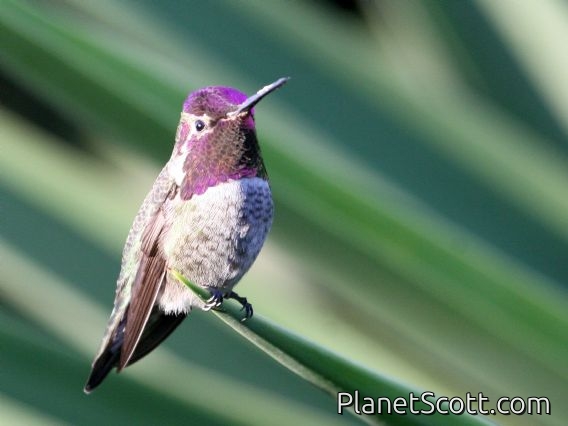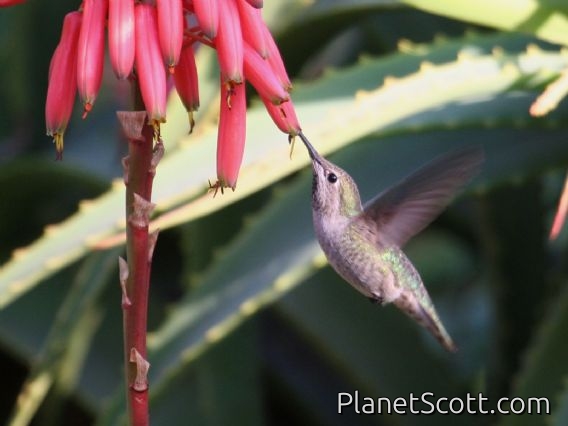Anna's Hummingbird (Calypte anna)

Anna's Hummingbird (Calypte anna) Male Breeding

Anna's Hummingbird (Calypte anna)


×



Anna's Hummingbird (Calypte anna) Male Breeding

Anna's Hummingbird (Calypte anna)
About Anna's Hummingbird (Calypte anna)
- Kingdom: Animals
- Phylum: Chordates
- Class: Birds
- Order: Hummingbirds and Swifts
- Family: Hummingbirds
Anna's hummingbird is a North American species of hummingbird named after Anna Masséna, Duchess of Rivoli.
Source: Wikipedia
Trips
Visits
-
1995-06-15
Mission - My Backyard, United States of America -
2006-02-14
Bernal Hill, United States of America -
2006-02-20
Pescadero Marsh, United States of America -
-
2006-06-06
McLaren Park, United States of America -
2007-01-01
Mission - My Backyard, United States of America -
2007-02-09
Golden Gate Park - Conservatory of Flowers, United States of AmericaFlowering succulents near dahlia garden. -
2007-04-07
Torrey Pines State Reserve, United States of America -
2007-12-07
Bernal Hill, United States of America -
-
2009-04-04
Bernal Hill, United States of America -
2010-01-03
Sacramento National Wildlife Refuge, United States of America -
2010-05-08
San Pedro Valley County Park, United States of America -
2010-11-06
Fort Mason, United States of America -
2011-11-19
Ferry Plaza, United States of America -
2012-08-12
Coyote Point County Park--harbor and marsh, United States of America -
2012-09-19
Golden Gate Park - North Lake, United States of America -
2012-09-22
East Wash, United States of America -
2012-12-02
Lake Merced , United States of America -
2013-03-17
Lake Merced , United States of America -
2013-03-23
Coyote Point County Park--harbor and marsh, United States of America -
2013-03-24
Fort Mason, United States of America -
2013-03-30
Heron's Head Park, United States of America -
2013-05-06
Mount Davidson, United States of America -
2013-06-05
Lake Tabeaud, United States of America -
2013-08-25
Ventana Wilderness, United States of America -
2013-08-31
Mountain Lake, United States of America -
2013-09-01
Glen Canyon Park, United States of America -
2013-09-07
Mountain Lake, United States of America -
2013-09-08
Bernal Hill, United States of America -
2013-09-13
Fort Mason, United States of America -
2013-09-28
Presidio - El Polin Spring, United States of America -
2013-10-05
Corona Heights, United States of America -
2013-10-06
Bernal Hill, United States of America -
2013-11-29
Lake Merced , United States of America -
2013-12-07
Golden Gate Park - San Francisco Botanical Garden, United States of America -
2014-01-04
Golden Gate Park - San Francisco Botanical Garden, United States of America -
2014-01-11
Heron's Head Park, United States of America -
2014-01-14
Candlestick Park, United States of America -
2014-02-01
San Pedro Valley County Park, United States of America -
2014-02-15
Lake Merced , United States of America -
2014-02-16
Golden Gate Park - North Lake, United States of America -
2014-02-16
Golden Gate Park - San Francisco Botanical Garden, United States of America -
2014-02-22
Panoche Valley, United States of America -
2014-03-09
Hahamongna Watershed Park, United States of America -
2014-03-09
Los Angeles County Arboretum and Botanic Garden, United States of America -
2014-03-10
Elfin Forest Preserve, United States of America -
2014-03-15
Alemany Community Garden, United States of America -
2014-03-22
Baker Beach, United States of America -
2014-04-19
Fort Mason, United States of America -
2014-04-26
Bernal Hill, United States of America -
2014-05-03
Glen Canyon Park, United States of America -
2014-06-01
Bayview Park, United States of America -
2014-06-07
Sunol Regional Wilderness--Visitor Center area, United States of America -
2014-06-15
Golden Gate Park - North Lake, United States of America -
2014-06-22
Redwood Valley, United States of America -
2014-07-12
Windy Hill OSP, United States of America -
2014-09-14
Buena Vista Park, United States of America -
2014-09-23
Redwood Valley, United States of America -
2014-09-27
Mount Davidson, United States of America -
2014-10-02
Golden Gate Park - San Francisco Botanical Garden, United States of America -
2014-11-29
Lafayette Park, United States of America -
2014-12-07
Sutro Heights--Baths / Land's End, United States of America -
2014-12-08
Golden Gate Park - San Francisco Botanical Garden, United States of America -
2014-12-18
Johnston House, United States of America -
2014-12-26
Sutro Heights--Baths / Land's End, United States of America -
2014-12-27
Heron's Head Park, United States of America -
2014-12-28
Glen Canyon Park, United States of America -
2015-01-01
Candlestick Park, United States of America -
2015-01-14
Bernal Hill, United States of America -
2015-01-17
Lafayette Park, United States of America -
2015-01-19
Lake Merced , United States of America -
-
-
-
-
-
-
-
-
-
-
-
-
-
-
-
-
-
-
-
-
-
-
-
-
-
-
-
-
-
-
-
-
-
-
-
-
-
-
-
-
-
-
-
-
-
-
-
-
-
-
-
-
-
-
-
-
-
-
-
-
-
-
-
-
-
-
-
-
-
-
-
-
-
-
-
-
-
-
-
-
-
-
-
-
-
-
-
-
-
-
-
-
-
-
-
-
-
-
-
-
-
2025-09-18
Charleston Road Marsh, United States of America








